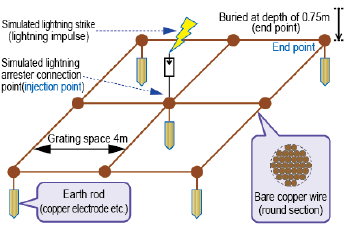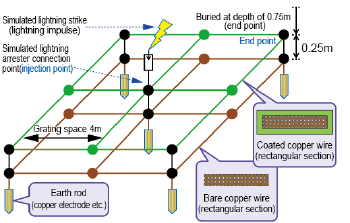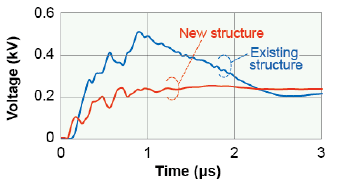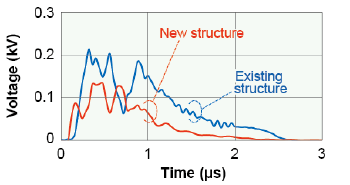9.Improving lightening resistance of electrical equipment using new grounding structure
As a countermeasure to earth fault and lightning strike damage to substations etc, wire mesh (bare copper stranded cables) is often buried around/under the equipment and connected to earthing rods to form a grounding structure (Fig.1 ). However, this existing structure was optimised for use with low frequencies, and is no longer offers adequate protection for today’s substations equipped with information communication technology (ICT).
As such, a new grounding structure has been designed. Given that potential rise in the grounding structure when lightening strikes may damage electrical equipment, flat rectangular section bare copper wires, which facilitate the flow of high frequency current were employed to reduce this problem (Fig. 2).
Experimental set ups were installed in the ground, as shown in the figures, for comparative tests. Results showed that the maximum voltage at the injection point to the new structure could be made 50% lower than in existing structures (Fig. 3).
Following on, voltage difference which occurs in grounding structures reduces the effectiveness of lightning protection devices such as lightning arresters, and is another cause for damage to equipment. Therefore, coated rectangular-section copper wires, with better voltage transfer charcteristics were connected in parallel. As a result, the maximum voltage difference between the injection point and the the end point was reduced by approximately 60% (Fig. 4).
Considering past data and the two results described above, it is expected that lightning damage can be decreased by 20%. Since the proposal requires changing the type of wire and double layered wires, introucing the the system will incur some cost, however, in relation to overall work on substations, the cost is relatively small.
Other Contents
- 1. Advanced seismograph for earthquake early warnings
- 2.Method for extracting vulnerable structures during earthquakes
- 3.Seismic reinforcement technology for earth retaining walls in narrow locations
- 4. Method for assessing tsunami damage to concrete bridges
- 5. Management of snowmelt for landslide prevention
- 6. Calculation of the aerodynamic coefficient on trains in half-bank half-cut line sections
- 7. Revision of evaluation criteria to check deterioration in lubricating grease used on trains
- 8.Method for detecting step-shaped wear on contact strips on pantograph heads
- 9.Improving lightening resistance of electrical equipment using new grounding structure
- 10.Proposal of method for diagnosing health of concrete masts for maintenance
- 11.On-board platform detection device to assist train crew in train door operation
- 12.Human factor analysis method using Potential Incidents Reports
- 1. Advanced seismograph for earthquake early warnings
- 2.Method for extracting vulnerable structures during earthquakes
- 3.Seismic reinforcement technology for earth retaining walls in narrow locations
- 4. Method for assessing tsunami damage to concrete bridges
- 5. Management of snowmelt for landslide prevention
- 6. Calculation of the aerodynamic coefficient on trains in half-bank half-cut line sections
- 7. Revision of evaluation criteria to check deterioration in lubricating grease used on trains
- 8.Method for detecting step-shaped wear on contact strips on pantograph heads
- 9.Improving lightening resistance of electrical equipment using new grounding structure
- 10.Proposal of method for diagnosing health of concrete masts for maintenance
- 11.On-board platform detection device to assist train crew in train door operation
- 12.Human factor analysis method using Potential Incidents Reports




